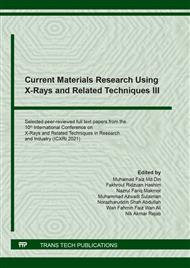[1]
M. Sheikholeslami, Solidification of NEPCM under the effect of magnetic field in a porous thermal energy storage enclosure using CuO nanoparticles, J. Mol. Liq. 263 (2018) 303–315. https://doi.org/10.1016/j.molliq.2018.04.144.
DOI: 10.1016/j.molliq.2018.04.144
Google Scholar
[2]
M. Sheikholeslami, Finite element method for PCM solidification in existence of CuO nanoparticles, J. Mol. Liq. 265 (2018) 347–355. https://doi.org/10.1016/j.molliq.2018.05.132.
DOI: 10.1016/j.molliq.2018.05.132
Google Scholar
[3]
E. o. lla. Ettefaghi, H. Ahmadi, A. Rashidi, A. Nouralishahi, S.S. Mohtasebi, Preparation and thermal properties of oil-based nanofluid from multi-walled carbon nanotubes and engine oil as nano-lubricant, Int. Commun. Heat Mass Transf. 46 (2013) 142–147. https://doi.org/10.1016/j.icheatmasstransfer.2013.05.003.
DOI: 10.1016/j.icheatmasstransfer.2013.05.003
Google Scholar
[4]
W. Dai, B. Kheireddin, H. Gao, H. Liang, Roles of nanoparticles in oil lubrication, Tribol. Int. 102 (2016) 88–98. https://doi.org/10.1016/j.triboint.2016.05.020.
DOI: 10.1016/j.triboint.2016.05.020
Google Scholar
[5]
M. Gulzar, H.H. Masjuki, M.A. Kalam, M. Varman, N.W.M. Zulkifli, R.A. Mufti, R. Zahid, Tribological performance of nanoparticles as lubricating oil additives, J. Nanoparticle Res. 18 (2016) 1–25. https://doi.org/10.1007/s11051-016-3537-4.
DOI: 10.1007/s11051-016-3537-4
Google Scholar
[6]
V. Srinivas, C.V.K.N.S.N. Moorthy, V. Dedeepya, P. V. Manikanta, V. Satish, Nanofluids with CNTs for automotive applications, Heat Mass Transf. Und Stoffuebertragung. 52 (2016) 701–712. https://doi.org/10.1007/s00231-015-1588-1.
DOI: 10.1007/s00231-015-1588-1
Google Scholar
[7]
S. Pradhan, J. Hedberg, E. Blomberg, S. Wold, I. Odnevall Wallinder, Effect of sonication on particle dispersion, administered dose and metal release of non-functionalized, non-inert metal nanoparticles, J. Nanoparticle Res. 18 (2016) 1–14. https://doi.org/10.1007/s11051-016-3597-5.
DOI: 10.1007/s11051-016-3597-5
Google Scholar
[8]
V. Zin, F. Agresti, S. Barison, L. Colla, M. Fabrizio, Influence of Cu, TiO2 nanoparticles and carbon nano-horns on tribological properties of engine oil, J. Nanosci. Nanotechnol. 15 (2015) 3590–3598. https://doi.org/10.1166/jnn.2015.9839.
DOI: 10.1166/jnn.2015.9839
Google Scholar
[9]
J. Lou, H. Zhang, R. Wang, Experimental investigation of graphite nanolubricant used in a domestic refrigerator, Adv. Mech. Eng. 7 (2015) 168781401557101. https://doi.org/10.1177/1687814015571011.
DOI: 10.1177/1687814015571011
Google Scholar
[10]
H. Zhu, C. Li, D. Wu, C. Zhang, Y. Yin, Preparation, characterization, viscosity and thermal conductivity of CaCO3 aqueous nanofluids, Sci. China Technol. Sci. 53 (2010) 360–368. https://doi.org/10.1007/s11431-010-0032-5.
DOI: 10.1007/s11431-010-0032-5
Google Scholar
[11]
A.N. Afifah, S. Syahrullail, N.A.C. Sidik, Magnetoviscous effect and thermomagnetic convection of magnetic fluid: A review, Renew. Sustain. Energy Rev. 55 (2016) 1030–1040. https://doi.org/10.1016/j.rser.2015.11.018.
DOI: 10.1016/j.rser.2015.11.018
Google Scholar
[12]
S.S.N. Azman, N.W.M. Zulkifli, H. Masjuki, M. Gulzar, R. Zahid, Study of tribological properties of lubricating oil blend added with graphene nanoplatelets, J. Mater. Res. 31 (2016) 1932–1938. https://doi.org/10.1557/jmr.2016.24.
DOI: 10.1557/jmr.2016.24
Google Scholar
[13]
K.G.K. Singh, R. Suresh, Behavior of Composite Nanofluids Under Extreme Pressure Condition, 1 (2018) 46–54.
Google Scholar
[14]
F.Y. Wang, T.Y. Wang, T.Y. Liao, M.Y. Liu, The complete mitochondrial genome sequence of Nemateleotris decora (gobiiformes, gobiidae), Mitochondrial DNA Part A DNA Mapping, Seq. Anal. 27 (2016) 4274–4275. https://doi.org/10.3109/19401736.2015.1082091.
DOI: 10.3109/19401736.2015.1082091
Google Scholar
[15]
A.N. Farhanah, S. Syahrullail, E.A. Rahim, Preparation and dispersion stability of graphite nanoparticles in palm oil, 19 (2018) 495–496.
Google Scholar
[16]
F. Yu, Y. Chen, X. Liang, J. Xu, C. Lee, Q. Liang, P. Tao, T. Deng, Dispersion stability of thermal nanofluids, Prog. Nat. Sci. Mater. Int. 27 (2017) 531–542. https://doi.org/10.1016/j.pnsc.2017.08.010.
DOI: 10.1016/j.pnsc.2017.08.010
Google Scholar
[17]
H. Setia, R. Gupta, R.K. Wanchoo, Stability of nanofluids, Mater. Sci. Forum. 757 (2013) 139–149. https://doi.org/10.4028/www.scientific.net/MSF.757.139.
DOI: 10.4028/www.scientific.net/msf.757.139
Google Scholar
[18]
A.S. Al-Janabi, M. Hussin, Stability and thermal conductivity of graphene in polyester nanolubricant, AIP Conf. Proc. 2267 (2020). https://doi.org/10.1063/5.0015740.
DOI: 10.1063/5.0015740
Google Scholar


